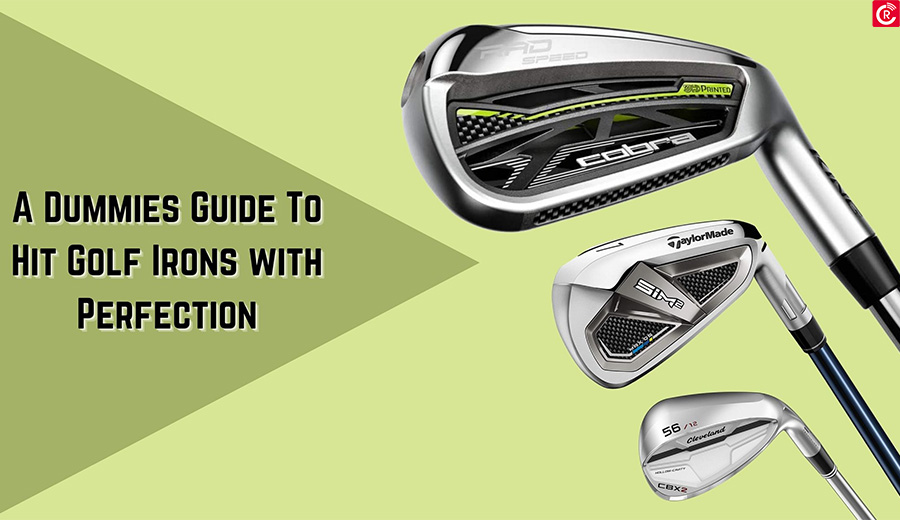
Golfers of all abilities can benefit from hitting their golf irons correctly. Irons are a sort of club used in the round of golf. Irons, unlike woods, have more temporary shafts, smaller heads, and cranked faces that make them better for making short-to-mid-range shots in a range of grass conditions.
The key to becoming a great shot with your irons is to adjust your stance and ball position to have the appropriate point of contact on the ball. Then, it’s simply a question of producing smooth, controlled swings that propel the ball forward, allowing the lofted head on the best golf clubs to provide the lift needed to send it flying.
Step1. Get Ready for a shot:
A. In your stance, place the ball somewhat in front of the center:
Standing with the ball closer to your lead foot is a little more beneficial. Many experts advocate aligning the ball with the emblem on your shirt’s breast pocket as a good starting point. If you aren’t wearing a shirt with a logo, this will be approximately two inches to the left (or right) of the center of your chest.
- Place the ball no farther ahead of your front armpit or behind your body than the middle of your body.
- Using a forward-facing stance will help you avoid chopping down on the ball, which usually results in short, erratic fading strokes.
B. To remain close to the ball, lean in slightly:
Bend forward at the waist, keeping your spine as straight as possible. Hold your head up to align your crown with your back and hips. Maintain this angle as long as possible until the club’s head leaves the head of the club.
- Take a deep breath and imagine your chest “hovering” over the ball until it strikes.
- Best forged irons are generally more concise than wood. As a result, maintaining your trunk and shoulders down throughout your swing, especially when blasting a drive, is critical.
C. Give yourself plenty of room to swing in a relaxed manner:
A decent rule of thumb is to keep a hand’s breadth between your arms and body. Too near to the ball will force you to swing immediately in front of your feet, which can make you feel cramped. On the other hand, if you’re too far away, the greater distance may result in a more horizontal angle for your swing, similar to that of a baseball bat.
Step2: Improving Your Golf Swing:
A. Make sure you’re striking the ball forward using gentle, low swings:
Keep your backswing “low and slow,” bringing the clubhead back, then reversing course and letting it swoop down to meet the ball in a shallow curve as you begin. When the club’s head is a few inches away from the ball, it should be moving straight ahead.
- Keep your wrists locked until you reach the peak of your swing, just as with any other shot.
- A less obvious swing trajectory will also ensure that the ball goes forward rather than upwards.
B. When making contact with the ball, bend your body away from it and tilt it:
Move your weight the same way you would when swinging a regular golf club; only keep your head and shoulders behind the ball at impact. It is where you should make your first impression on the ball. Then, by establishing a consistent speed, you’ll be able to maintain control of the shot and channel all of your momenta into it.
- Avoid pushing your body into a tight bend from the top of your head to the foot of your back leg.
- Make sure your left shoulder is higher than your right if you’re a right-handed golfer. Keep your right shoulder raised if you’re left-handed.
C. Use the “Shape” button to adjust the direction of your shot more precisely:
To alter the ball’s path, turn the clubhead a few degrees to the left or right as needed. Shaping, when done well, can improve your overall accuracy and control, especially on hilly courses or in windy situations.
- If you’re playing a club on your left-hand side with a little bank, adjusting it to the left a little can help you compensate for the slope and get the ball closer to the hole.
- Shaping is a more complicated technique that needs a lot of practice to master. It might take dozens or even hundreds of swings before you’re able to hit the ball where you want it to go.
D. Hold your posture throughout the complete swing:
Make sure your head, back, shoulders, arms, hips, and feet are in the right place before you swing until the ball is clear of your club. It’s possible that any part of your technique breaks down between your backswing and follow-through, increasing the chance of a mishit.
- Don’t be tempted to stand up or puff your chest and shoulders before the ball comes close enough. It will not increase your amount of loft—rather, it will decrease it.
- Don’t fall into the trap of coming out of position early by practicing to freeze for 1-2 full seconds after your follow-through.
Step3: Operating Your Irons Virtually:
A. Allow the club to lift the ball rather than hurl it into the air:
The common blunder of inexperienced gamers is attempting to “scoop” the ball or throw it into the air to make it fly. But, of course, you only lose accuracy and distance by doing this.
The lofted head of the club is what causes lift, so concentrate on connecting squarely and pushing the ball forward. The best golf irons will handle the rest.
- Take a few half-speed swings with a putter to get the hang of hitting forward, then try your iron and repeat the same motion.
B. After, each shot, double-check your divots:
A decent iron shot frequently results in a divot caused by the club’s head cutting into the earth following impact with the ball, removing soil with it. The divots formed by a pitching machine are significantly deeper, wider, and more consistent than those made by human beings. Because of their depth and width, they can be indicators of strong, accurate swings. With enough practice, you’ll notice divots popping up after almost every shot.
C. Play your irons to extricate yourself from sticky situations:
Irons are built to reach below the ball and raise them off the ground. They are excellent for saving the best golf balls from wilder course sections, such as rough, low brush, bunkers, and even shallow water hazards. Just make sure you get an iron with a loft suitable for the terrain’s severity.
Conclusion:
To hit a golf iron correctly, you need to understand how the club works. This is because when you make a golf swing, you are hitting two clubs at once- the driver and the iron. It is why it’s important to use the correct technique when swinging an iron since it will affect how your ball flies.





